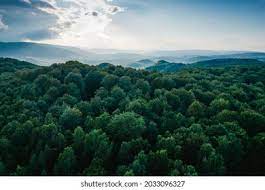THE ROLE OF FORESTS IN CLIMATE CHANGE MITIGATION
Forests cover around 30% of the total surface on Earth. As forests mature, their
trees absorb carbon from the atmosphere and store it in wood, plant matter, and
beneath the soil. Without trees, much of this carbon would remain in the atmosphere
as carbon dioxide (CO2), the primary greenhouse gas causing climate change.
Stopping the loss and degradation of forest ecosystems and encouraging their
regeneration of them have the ability to contribute more than one-third of the total
worldwide climate change mitigation necessary by 2030 for achieving the Paris
Agreement’s objectives.
Forests are expected to have removed an average of 2 billion metric tonnes of
carbon from the atmosphere per year since 2000.1 This “carbon sink function” of
forests delays climate change by reducing the velocity at which carbon dioxide
(CO2) primarily from fossil fuel combustion, accumulates in the atmosphere.
Appropriate forest management can thus be an essential technique for combating
future climate change.
However, about 12 million hectares of forest are destroyed each year. This
deforestation, together with agriculture and other land use changes, accounts for
around 25% of global greenhouse gas emissions.
Deforestation and land degradation may threaten attempts to enhance resistance to
climate effects and endanger forest dwellers.
Agricultural commodities such as palm oil, cattle, soy, plywood, pulp, and paper
account for over 70% of tropical deforestation. To reverse this tendency,
commodities production must be decoupled.
Other significant advantages to both humans and nature include:
● Globally, 1.6 billion people (almost 25% of the world’s population) rely on
forests for a living, and many of them are among the poorest people on the
planet.
● Forests contribute $75-100 billion annually in goods and amenities, including
clean water and healthy soils.
● 80% of the world’s terrestrial biodiversity is found in forests.
● Forests assist in preventing erosion, enhancing and conserving soil,
protecting people from landslides and floods, and producing the rich topsoil
required to grow plants and commodities.
● Forest time has been demonstrated to improve illnesses such as heart
disease, respiratory issues, diabetes, and mental well-being.
● After the oceans, forests are the greatest carbon storehouses, since they
collect the greenhouse gas from the atmosphere and store it above and below
ground.
SOLUTION
Fighting deforestation and forest degradation in biodiverse and culturally significant
locations, such as natural forests and sites of World Heritage importance. This
contributes to the preservation of the services that forests provide to people and
society, such as forest carbon stores and livelihoods.
Restoring forest landscapes aids in the mitigation and adaptation to climate change.
A worldwide endeavor to restore 350 million hectares of deforested and degraded
land by 2030, the International Union For Conservation Of Nature (IUCN) assists
national and sub-national decision-makers in meeting this critical aim. India’s Bonn
Challenge pledge was to bring 13 million hectares of degraded land into restoration
by 2020 and 8 million hectares by 2030.
IUCN’s Relevance in India
The International Union for Conservation of Nature (IUCN) is a global organization
dedicated to promoting sustainable development and nature conservation. Founded
in 1948, the IUCN serves as a platform for governments, NGOs, scientists, and local
communities to collaborate and address pressing environmental issues. Its primary
goals include assessing the conservation status of species, supporting the
establishment of protected areas, and promoting sustainable use of natural
resources.
The IUCN employs scientific research, advocacy, and policy development to drive
positive change and ensure the preservation of biodiversity and ecosystems
worldwide.
The relevance of the IUCN in India cannot be overstated. India is home to a rich and
diverse array of wildlife, ecosystems, and natural resources. With its growing
population and development needs, the country faces unique challenges in
balancing economic growth and environmental conservation.
The IUCN plays a crucial role in supporting India’s conservation efforts by providing
scientific expertise, conducting assessments of endangered species, and assisting
in the development of conservation policies and strategies. It collaborates closely
with the Indian government, NGOs, and local communities to address issues such as
habitat loss, wildlife poaching, climate change, and sustainable development.
Conclusion
By leveraging the global knowledge and resources of the IUCN, India can effectively
protect its natural heritage while promoting sustainable development practices for
the benefit of present and future generations
For a more informed decision and to promote afforestation, it is crucial to inform the
community in decision-making.
This will probably awoke a sense of belonging and ownership to their own natural
setting. Enhancing local control over woods will also assist to relieve
impoverishment, strengthen women and men, increase biodiversity, and manage
forests in a sustainable manner.


